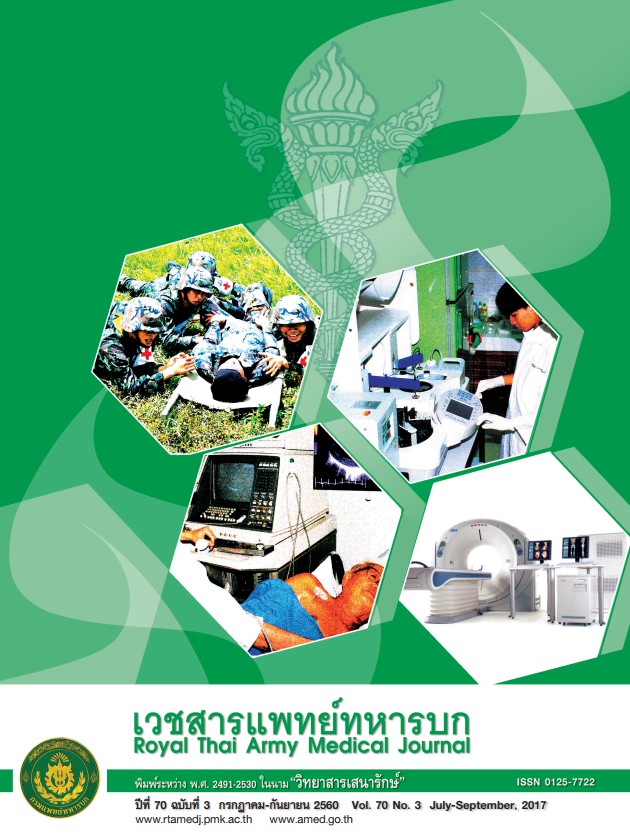Evaluation of Pre-treatment Neutrophil to Lymphocyte Ratio (NLR) in Prediction of Disease Free Survival (DFS) in Patients with Operable Breast Cancers
Main Article Content
บทคัดย่อ
Introduction: Breast cancer is the most common type of cancer in females. Despite the widespread adoption of adjuvant treatments, resulted in improved survival, nearly 20% of patients with early breast cancer still had recurrence of disease. As of the heterogeneity of disease, validated clinical, pathological and molecular prognostic factors currently used in decision-making to provide an optimal adjuvant treatment for these patients are some what inadequate and are needed to be further exploration. Increasing evidence suggests that cancer initiation, progression and dissemination are affected by host’s immune response in both systemic and the local tumor milieu. The production and release of neutrophils are increased in the bone marrow in response to tumor-related/induced inflammation. This inflammation shows an inverse effect on peripheral blood lymphocyte count due to cytokines. The neutrophil count increases whilst lymphocyte count decreases in peripheral blood. Objective: To evaluate the pre-treatment neutrophil to lymphocyte ratio (NLR) in prediction of disease free survival (DFS) in patients with operable breast cancers. Materials and Methods: Retrospective analysis in 240 patients with early breast cancer who operated during January 2012 to December 2013. The study was ethical approved by Institutional Review Board, Royal Thai Army Medical Department. In this study, we evaluated the association of pre-treatment NLR and recurrence of disease in patients with operable breast cancers undergoing curative surgery and adjuvant therapy. Result: High level of pre-treatment NLR (≥ 4) was found to be an independent predictor for early recurrence in short term follow up (39 months). Conclusion: Our study has confirmed previous published findings and documented novel findings regarding the prognostic significant of pre-treatment NLR in patients with early (operable) breast cancers. We believe that the clinical application of pre-treatment NLR as one of major prognostic biomarker in treatment of operable breast cancer will be achieved in a very near future.
ความเป็นมา มะเร็งเต้านมเป็นมะเร็งที่พบมากที่สุดในผู้หญิง ปัจจุบันถึงแม้จะมีการพัฒนาของการรักษาเสริมหลังผ่าตัดทั้งยาเคมีบำบัดยาต้านฮอร์โมน รวมทั้งการฉายรังสี หลังจากได้รับการรักษามะเร็งเต้านม ซึ่งเพิ่มอัตรารอดชีวิตของผู้ป่วยให้ยาวมากขึ้น แต่ก็โอกาสพบมะเร็งกลับมาใหม่ หรือตรวจพบมะเร็งแพร่กระจายได้ถึงร้อยละ 20 มีหลายปัจจัยพยากรณ์โรคที่จะนำมาช่วยในการตัดสินใจเลือกการรักษาเสริมที่เหมาะสมในผู้ป่วยแต่ละคน วัตถุประสงค์ เพื่อประเมินความสามารถของค่าอัตราส่วนของเม็ดเลือดขาวนิวโทรฟิลต่อเม็ดเลือดขาวลิมโฟไซต์ในกระแสเลือดก่อนการรักษา ในการทำนายระยะปลอดโรคของผู้ป่วยมะเร็งเต้านมหลังได้รับการรักษาแล้ววิธีการรวบรวมข้อมูลผู้ป่วยมะเร็งเต้านมระยะแรกที่ได้รับการรักษาด้วยการผ่าตัด จำนวน 240 คน หาค่าอัตราส่วนของเม็ดเลือดขาวนิวโทรฟิลต่อเม็ดเลือดขาวลิมโฟไซต์ในกระแสเลือดก่อนการรักษาและการกลับเป็นซ้ำของมะเร็งเต้านมภายหลังการรักษาด้วยการผ่าตัดและการรักษาเสริม วิเคราะห์หาค่าความแตกต่างและความสัมพันธ์ของปัจจัยต่างๆ ระหว่างทั้งสองกลุ่ม ผลการศึกษา พบว่าค่าอัตราส่วนของเม็ดเลือดขาวนิวโทรฟิลต่อเม็ดเลือดขาวลิมโฟไซต์ในกระแสเลือดก่อนการรักษาในระดับที่สูง≥ 4 เป็นปัจจัยพยากรณ์การกลับเป็นซ้ำของโรคในการติดตามช่วงระยะสั้น (39 เดือน)
Downloads
Article Details
บทความในวารสารนี้อยู่ภายใต้ลิขสิทธิ์ของ กรมแพทย์ทหารบก และเผยแพร่ภายใต้สัญญาอนุญาต Creative Commons Attribution-NonCommercial-NoDerivatives 4.0 International (CC BY-NC-ND 4.0)
ท่านสามารถอ่านและใช้งานเพื่อวัตถุประสงค์ทางการศึกษา และทางวิชาการ เช่น การสอน การวิจัย หรือการอ้างอิง โดยต้องให้เครดิตอย่างเหมาะสมแก่ผู้เขียนและวารสาร
ห้ามใช้หรือแก้ไขบทความโดยไม่ได้รับอนุญาต
ข้อความที่ปรากฏในบทความเป็นความคิดเห็นของผู้เขียนเท่านั้น
ผู้เขียนเป็นผู้รับผิดชอบต่อเนื้อหาและความถูกต้องของบทความของตนอย่างเต็มที่
การนำบทความไปเผยแพร่ซ้ำในรูปแบบสาธารณะอื่นใด ต้องได้รับอนุญาตจากวารสาร


